| Oracle® Database 2 Day + Performance Tuning Guide 11g Release 1 (11.1) Part Number B28275-01 |
|
|
View PDF |
| Oracle® Database 2 Day + Performance Tuning Guide 11g Release 1 (11.1) Part Number B28275-01 |
|
|
View PDF |
The Performance page in Oracle Enterprise Manager (Enterprise Manager) displays information in three sections that you can use to assess the overall performance of the database in real time.
Typically, you should use the automatic diagnostic feature of Automatic Database Diagnostic Monitor (ADDM) to identify performance problems with the database, as described in Chapter 3, "Automatic Database Performance Monitoring". In some cases, however, you may want to monitor the database performance in real time to identify performance problems as they happen. For example, ADDM performs its analysis after each Automatic Workload Repository (AWR) snapshot, which by default is once every hour. However, if you notice a sudden spike in database activity on the Performance page, then you may want to investigate the incident before the next ADDM analysis.
By drilling down to appropriate pages from the Performance page, you can identify performance problems with the database in real time. If you find a performance problem, then you can choose to run ADDM manually to analyze it immediately, without having to wait until the next ADDM analysis. To learn how to run ADDM manually to analyze performance in real time, see "Manually Running ADDM to Analyze Current Database Performance".
This chapter contains the following sections:
The Average Active Sessions chart of the Performance page shows potential problems inside the database, including how much CPU users are consuming. The wait classes show how much of the database activity is consumed by waiting for a resource such as disk I/O.
By following the performance method explained in Chapter 2, "Oracle Database Performance Method", you can drill down from the charts to identify the cause of instance-related performance issues and resolve them.
To monitor user activity:
From the Database Home page, click Performance.
The Performance page appears.
Locate the spikes in the Average Active Sessions chart.
When the CPU Used value reaches the Maximum CPU line (shown as a dotted line), the database instance is running at 100 percent of CPU time on the host system.
All other values in the chart represent users waiting and contention for resources, which are categorized by wait classes in the legend. Values that use a larger block of active sessions represent bottlenecks caused by a particular wait class, as indicated by the corresponding color in the legend.
In the chart shown in Figure 4-2, the largest block of activity appears in green and corresponds to the CPU Used wait class as described in the legend.
To identify each wait class, move your cursor over the block in the Average Active Sessions chart corresponding to the class.
The corresponding wait class is highlighted in the chart legend.
Click the largest block of color on the chart or its corresponding wait class in the legend to drill down to the wait class with the most active sessions.
If you click CPU Used, then the Active Sessions Working page for the wait class appears. If you click a different wait class, such as User I/O, then the Active Sessions Waiting page appears.
The Active Sessions Working page shows a 1-hour time line. Details for each wait class are shown in 5-minute intervals under Detail for Selected 5 Minute Interval.
You can view the details of wait classes in different dimensions by proceeding to one of the following sections:
To change the time selected interval, move the slider below the chart to a different interval.
The information contained in the Detail for Selected 5 Minute Interval section is automatically updated to display the selected time period.
In the example shown in Figure 4-3, the 5 -minute interval from 5:03 to 5:08 is selected for the CPU Used wait class.
If you discover a performance problem, then you can attempt to resolve it in real time. On the Performance page, do one of the following:
Click a snapshot below the chart that corresponds to the time when the performance problem occurred to run ADDM for that time period.
For information about ADDM analysis, see "Reviewing the Automatic Database Diagnostic Monitor Analysis".
Create a snapshot manually by clicking Run ADDM Now.
For information about creating snapshots manually, see "Creating Snapshots". For information about running ADDM manually, see "Manually Running ADDM to Analyze Current Database Performance".
Click Run ASH Report to create an ASH report to analyze transient performance problems that last for only a short period of time.
For information about ASH reports, see "Active Session History Reports".
On the Active Sessions Working page, the Top Working SQL table shows the database activity for actively running SQL statements that are consuming CPU resources. The Activity (%) column shows the percentage of this activity consumed by each SQL statement. If one or several SQL statements are consuming a majority of the activity, then you should investigate them.
In the example shown in Figure 4-4, the SELECT statement is consuming over 90% of database activity and should be investigated.
To monitor the top working SQL statements:
On the Performance page, in the Average Active Sessions chart, click the CPU block on the chart or its corresponding wait class in the legend.
The Active Sessions Working page appears.
Under Detail for Selected 5 Minute Interval, click the SQL ID link of the most active SQL statement in the Top Working SQL table.
The SQL Details page appears.
For SQL statements that are using the majority of the wait time, use SQL Tuning Advisor or create a SQL Tuning Set to tune the problematic SQL statements.
On the Active Sessions Working page, the Top Working Sessions table displays the top sessions waiting for the corresponding wait class during the selected time period. Sessions represent specific user connections to the database through a user process.
A session lasts from the time the user connects to the database until the time the user disconnects or exits the database application. For example, when a user starts SQL*Plus, the user must provide a valid database user name and password to establish a session. If a single session is using the majority of the wait time, then you should investigate it.
To monitor the top working sessions:
On the Performance page, in the Average Active Sessions chart, click the CPU Used block on the chart or its corresponding wait class in the legend.
The Active Sessions Working page appears.
Under Detail for Selected 5 Minute Interval, click the Session ID link of the session consuming the most database activity.
The Session Details page appears.
This page contains information such as session activity, session statistics, open cursors, blocking sessions, wait events, and parallel SQL for the selected session.
In the example shown in Figure 4-5, the SQL*Plus session for user sh is consuming over 96% of database activity and should be investigated.
In this example, because the session is consuming 100 percent of database activity, consider ending the session by clicking Kill Session, and proceeding to tune the SQL statement that this session is running.
See Also:
The Top Services table displays the top services waiting for the corresponding wait event during the selected time period.
Services represent groups of applications with common attributes, service-level thresholds, and priorities. For example, the SYS$USERS service is the default service name used when a user session is established without explicitly identifying its service name. The SYS$BACKGROUND service consists of all Oracle Database background processes. If a single service is using the majority of the wait time, then you should investigate it.
To monitor a service:
On the Performance page, in the Average Active Sessions chart, click a block on the chart or its corresponding wait class in the legend.
The Active Sessions Working page appears.
Under Detail for Selected 5 Minute Interval, select Top Services from the View list.
The Top Services table appears.
In the example shown in Figure 4-7, the SYS$USERS service is consuming 97.32% of database activity. This service corresponds to the SQL*Plus session for user sh shown in Figure 4-5.
Click the Service link of the most active service.
The Service page appears.
This page contains information about the modules, activity, and statistics for the selected service.
The Top Modules table displays the top modules waiting for the corresponding wait event during the selected time period.
Modules represent the applications that set the service name as part of the workload definition. For example, the DBMS_SCHEDULER module may assign jobs that run within the SYS$BACKGROUND service. If a single module is using the majority of the wait time, then it should be investigated.
To monitor a module:
On the Performance page, in the Average Active Sessions chart, click a block on the chart or its corresponding wait class in the legend.
The Active Sessions Working page appears.
Under Detail for Selected 5 Minute Interval, select Top Modules from the View list.
The Top Modules table appears.
Click the Module link of the module that is showing the highest percentage of activity.
The Module page appears.
This page contains information about the actions, activity, and statistics for the selected module.
In the example shown in Figure 4-8, the SQL*Plus module is consuming over 95% of database activity and should be investigated. As shown in Figure 4-5, the SQL*Plus session for user sh is consuming a huge percentage of database activity.
The Top Actions table displays the top actions waiting for the corresponding wait event during the selected time period.
Actions represent the jobs that are performed by a module. For example, the DBMS_SCHEDULER module can run the GATHER_STATS_JOB action to gather statistics on all database objects. If a single action is using the majority of the wait time, then you should investigate it.
To monitor an action:
On the Performance page, in the Average Active Sessions chart, click a block on the chart or its corresponding wait class in the legend.
The Active Sessions Working page appears.
Under Detail for Selected 5 Minute Interval, select Top Actions from the View list.
The Top Actions table appears.
Click the Action link of the most active action.
The Action page appears.
This page contains statistics for the selected action.
In the example shown in Figure 4-9, the action associated with the SQL*Plus module and SALES_INFO action is consuming 96% of the database activity. This information is consistent with Figure 4-5, which shows that the SQL*Plus session for user sh is consuming over 96% of database activity.
The Top Clients table displays the top clients waiting for the corresponding wait event during the selected time period. A client can be a Web browser or any end-user process that initiates requests for an operation to be performed on the database. If a single client is using the majority of the wait time, then you should investigate it.
To monitor a client:
On the Performance page, in the Average Active Sessions chart, click a block on the chart or its corresponding wait class in the legend.
The Active Sessions Working page appears.
Under Detail for Selected 5 Minute Interval, select Top Clients from the View list.
The Top Clients table appears.
Click the Client ID link of the most active client.
The Clients page appears.
This page contains statistics for the selected user process.
The Top PL/SQL table displays the top PL/SQL subprograms waiting for the corresponding wait event during the selected time period. If a single PL/SQL subprogram is using the majority of the wait time, then you should investigate it.
To monitor a PL/SQL subprogram:
On the Performance page, in the Average Active Sessions chart, click a block on the chart or its corresponding wait class in the legend.
The Active Sessions Working page appears.
Under Detail for Selected 5 Minute Interval, select Top PL/SQL from the View list.
The Top PL/SQL table appears.
Click the PL/SQL Subprogram link of the most active subprogram.
The PL/SQL Subprogram page appears.
This page contains statistics for the selected subprogram.
In Figure 4-11, the SYSMAN.MGMT_JOB_EXEC_UPDATE subprogram is consuming 100% of database activity.
The Top Files table displays the average wait time for specific files during the selected time period. This data is available from the Active Sessions Waiting: User I/O page.
To monitor a file:
On the Performance page, in the Average Active Sessions chart, click the User I/O block on the chart or its corresponding wait class in the legend.
The Active Sessions Waiting: User I/O page appears.
Under Detail for Selected 5 Minute Interval, select Top Files from the View list.
The Top Files table appears.
Click the Tablespace link of the file with the highest average wait time.
The View Tablespace page appears.
In the example shown in Figure 4-12, the wait times are all associated with I/O for the file in the SYSTEM tablespace.
The Top Objects table displays the top database objects waiting for the corresponding wait event during the selected time period. This data is available from the Active Sessions Waiting: User I/O page.
To monitor an object:
On the Performance page, in the Average Active Sessions chart, click the User I/O block on the chart or its corresponding wait class in the legend.
The Active Sessions Waiting: User I/O page appears.
Under Detail for Selected 5 Minute Interval, select Top Objects from the View list.
The Top Objects table appears.
Click the Object Name link of the object with the highest average wait time.
The View page for the object appears.
This example in Figure 4-13 shows that all the waits are for the SYS.I_SYSAUTH1 index. Given the information in Figure 4-4 and Figure 4-5, you can conclude that the performance problem is caused by the SELECT statement executed by user sh, which is waiting for access to the SYS.I_SYSAUTH1 index.
In the Average Active Sessions section of the Performance page, you can use the Throughput, I/O, Parallel Execution, and Services charts to monitor database instance activity. As explained in "Customizing the Database Performance Page", you can also customize the Performance page so that the most useful charts are displayed by default.
You can use the instance activity charts to perform the following tasks:
The Throughput charts show any contention that appears in the Average Active Sessions chart. The charts indicate how much work the database is performing for the user. The Throughput charts on the Performance page display:
Number of physical reads, redo size, logons, and transactions per second
Number of physical reads and redo size per transaction
Compare the peaks on the Throughput charts with the peaks on the Average Active Sessions chart. If the Average Active Sessions chart displays a large number of sessions waiting, indicating internal contention, but throughput is high, then the situation may be acceptable. The database is probably also performing efficiently if internal contention is low but throughput is high. However, if internal contention is high but throughput is low, then consider tuning the database.
To monitor throughput:
From the Database Home page, click Performance.
The Performance page appears.
In the instance activity chart, click Throughput.
The Throughput charts are shown with Instance Throughput Rate set to the default value of Per Second. You can select Per Transaction to show the throughput rate per transaction.
In the example in shown in Figure 4-15, the number of transactions and physical reads per second spiked at around 10:45 a.m. The number of transactions per second has remained between 1000 and 2000 for 25 minutes. The physical reads have remained between 500 and 1000 KB per second.
To view the top consumers for each type of activity, click the corresponding link in the legend.
The Top Consumers page appears. This page shows the top sessions for the selected activity.

In this example, a SQL*Plus session created by operating system user lashdown is responsible for the increase in database throughput.
Select any session and click View to obtain more information.
After you analyze the information, you can choose to end the session by clicking Kill Session, or return to the Performance page.
The I/O charts show I/O statistics collected from all database clients. The I/O wait time for a database process represents the amount of time that the process could have been doing useful work if a pending I/O had completed. Oracle Database captures the I/O wait times for all important I/O components in a uniform fashion so that every I/O wait by any Oracle process can be deduced from the I/O statistics.
The Latency for Synchronous Single Block Reads chart shows the total perceived I/O latency for a block read, which is the time difference between when an I/O is issued and when it is processed by the database. Most systems are performing satisfactorily if latency is fewer than 10 milliseconds. This type of I/O request is the best indicator of I/O performance for the following reasons:
Write operations may exhibit good performance because of write caches in storage.
Because multiblock I/O requests have varying sizes, they can take different amounts of time.
The latency of asynchronous I/O requests does not represent the full I/O wait time.
The other charts shown depend on your selection for I/O Breakdown, as described in the following sections:
The I/O Function charts determine I/O usage level by application or job. The component-level statistics give a detailed view of the I/O bandwidth usage, which you can then use in scheduling jobs and I/O provisioning. The component-level statistics fall in the following categories:
Background type
This category includes ARCH, LGWR, and DBWR.
Activity
This category includes XML DB, Streams AQ, Data Pump, Recovery, and RMAN.
I/O type
The category includes Direct Write, which is a write issued by a foreground process that is not from the buffer cache; Direct Read, which is a physical I/O from a datafile that bypasses the buffer cache and reads the data block directly into process-private memory; and Buffer Cache Read.
Others
This category includes I/Os such as control file I/Os.
To monitor I/O by function:
From the Database Home page, click Performance.
The Performance page appears.
In the instance activity chart, click I/O.
The I/O Megabytes per Second and I/O Requests per Second charts appear.
For I/O Breakdown, select I/O Function.
The I/O Megabytes per Second by I/O Function and I/O Requests per Second by I/O Function charts appear.
The example in Figure 4-16 shows that a significant amount of I/O is being performed by the log writer. The log writer activity peaked at around 550 I/O requests per second.
Click the largest block of color on the chart or its corresponding function in the legend to drill down to the function with the highest I/O rate.
The I/O Details page appears.
You can view real-time or historical data for details on I/O megabytes or I/O requests.
See Also:
Oracle Database Concepts to learn about database background processes such as ARCH, LGWR, and DBWR
The I/O Type charts enable you to monitor I/O by the types of read and write operations. Small I/Os are requests smaller than 128 KB and are typically single database block I/O operations. Large I/Os are requests greater than or equal to 128 KB. Large reads are generated by database operations such as table/index scans, direct data loads, backups, restores, and archiving.
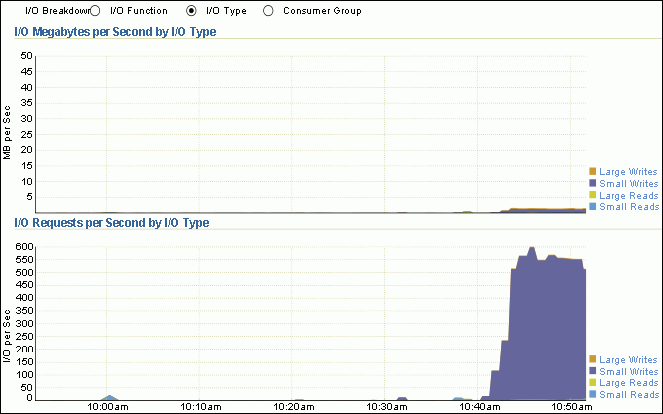
If you are optimizing for low transaction times, then monitor the rate at which I/O requests are completed. Single-block performance is optimal when there is low I/O latency. High latencies typically indicate that the storage system is a bottleneck. Performance is negatively impacted by large I/O workloads.
If you are optimizing for large queries, such as in a data warehouse, then performance is dependent on the maximum throughput your storage system can achieve rather than the latency of the I/O requests. In this case, monitor the I/O megabytes per second rather than the synchronous single-block read latencies.
To monitor I/O by type:
From the Database Home page, click Performance.
The Performance page appears.
In the instance activity chart, click I/O.
The I/O Megabytes per Second and I/O Requests per Second charts appear
For I/O Breakdown, select I/O Type.
The I/O Megabytes per Second by I/O Type and I/O Requests per Second by I/O Type charts appear.
In this example, the number of small writes per second increased to 550. These writes correspond to the log writer I/O requests shown in Figure 4-16.
Click the largest block of color on the chart or its corresponding function in the legend to drill down to the function with the highest I/O rate.
The I/O Details page appears.
You can view real-time or historical data for details on I/O megabytes or I/O requests.
When Oracle Database Resource Manager is enabled, the database collects I/O statistics for all consumer groups that are part of the currently enabled resource plan. The Consumer Group charts enable you to monitor I/O by consumer group.
A resource plan specifies how the resources are to be distributed among various users (resource consumer groups). Resource consumer groups let you group user sessions together by resource requirements. Note that the _ORACLE_BACKGROUND_GROUP_ consumer group contains I/O requests issued by background processes.
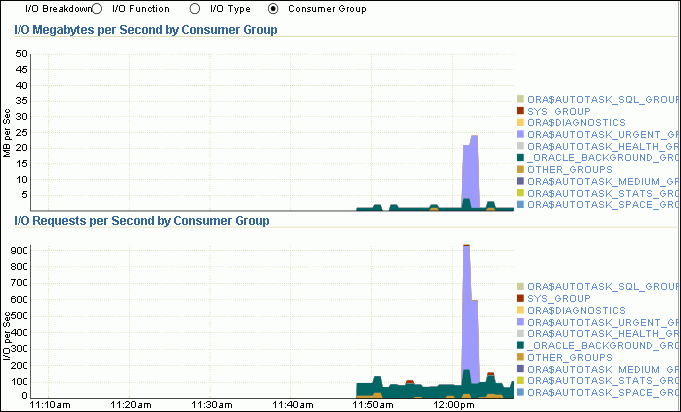
To monitor I/O requests by consumer group:
From the Database Home page, click Performance.
The Performance page appears.
In the instance activity chart, click I/O.
The I/O Megabytes per Second and I/O Requests per Second charts appear.
For I/O Breakdown, select Consumer Group.
The I/O Megabytes per Second by Consumer Group and I/O Requests per Second by Consumer Group charts appear.
The Parallel Execution charts show system metrics related to parallel queries. A parallel query divides the work of executing a SQL statement across multiple processes. The charts show parallel queries that were waiting for a particular wait event that accounted for the highest percentages of sampled session activity.
Figure 4-17 Monitoring Parallel Execution

To monitor parallel execution:
From the Database Home page, click Performance.
The Performance page appears.
In the instance activity chart, click Parallel Execution.
The Parallel Execution charts appear.
Two pairs of charts are displayed. The first pair of charts shows the number of sessions on the y-axis, whereas the second pair shows the per second rate on the y-axis.
In the example shown in Figure 4-17, query parallelization was active between 11:30 a.m. to 12:20 p.m.
The Services charts show services waiting for the corresponding wait event during the time period shown. Services represent groups of applications with common attributes, service-level thresholds, and priorities. For example, the SYS$USERS service is the default service name used when a user session is established without explicitly identifying its service name. Only active services are shown.
To monitor services:
From the Database Home page, click Performance.
The Performance page appears.
In the instance activity chart, click Services.
The Services chart appears.
In Figure 4-18, the emdc and SYS$USERS services have the greatest number of active sessions.
Click the largest block of color on the chart or its corresponding service in the legend to drill down to the service with the highest number of active sessions.
The Service page appears, showing the Activity subpage.

You can view real-time data showing the session load for all wait classes associated with the service.
The Host chart on the Performance page displays utilization information about the system hosting the database.
To determine if the host system has enough resources available to run the database, establish appropriate expectations for the amount of CPU, memory, and disk resources that your system should be using. You can then verify that the database is not consuming too many of these resources.
To view details about CPU, memory, and disk utilization:
From the Database Home page, click Performance.
The Performance page appears.
Click Load Average in the legend for the Host chart.
The Host page appears, showing the Performance subpage.
The Performance Summary view is shown by default. The Performance Summary view displays metric values for CPU utilization, memory utilization, disk I/O utilization, and the top 10 processes ordered by both CPU and memory utilization.
Determine whether sufficient resources are available and whether when your system is using too many resources.
Determine the amount of CPU, memory, and disk resources the database uses in the following scenarios:
When your system is idle, or when little database and nondatabase activity exists
At average workloads
At peak workloads
Workload is an important factor when evaluating the level of resource utilization for your system. During peak workload hours, 90 percent utilization of a resource, such as a CPU with 10 percent idle and waiting time, can be acceptable. However, if your system shows high utilization at normal workload, then there is no room for additional workload.
Use the procedures in the following sections to monitor the host activity for your database:
Set the appropriate threshold values for the performance metrics so the system can automatically generate alerts when these thresholds are exceeded.
For information about setting metric thresholds, see "Setting Metric Thresholds for Performance Alerts".
To address CPU problems, first establish appropriate expectations for the amount of CPU resources your system should be using. You can then determine whether sufficient CPU resources are available and recognize when your system is consuming too many resources. This section describes how to monitor CPU utilization.
From the Database Home page, click Performance.
The Performance page appears.
In the Host chart, click Load Average in the legend.
The Host page appears, showing the Performance subpage.
Select CPU Details from the View list.
The CPU Details view appears.
This view contains statistics about CPU utilization, I/O wait times, and load gathered over the last hour. The top 10 processes are also listed ordered by CPU utilization.

Verify the current CPU utilization using the CPU Utilization chart.
The CPU Utilization chart shows CPU utilization over the last hour. The current value is displayed below the chart. During standard workload hours, the value should not exceed the critical threshold.
Click CPU Utilization.
The CPU Utilization page appears.
This page contains CPU utilization statistics and related alerts generated over the last 24 hours.
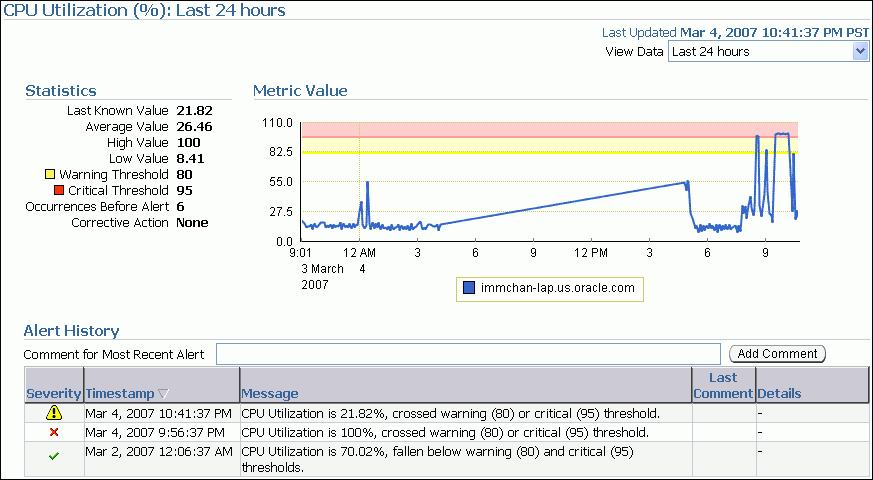
In this example, the CPU utilization crossed the critical threshold value at 9:56 p.m., so an alert for CPU utilization is generated to indicate that a CPU performance problem may exist.
If you notice an unexpected spike in this value that is sustained through normal workload hours, then the CPU performance problem should be investigated.
Verify the current CPU I/O wait time using the CPU I/O Wait chart.
The CPU I/O Wait chart shows CPU I/O wait time over the last hour. The current value is displayed below the chart. During normal workload hours, the value of CPU I/O wait should not exceed the warning threshold.
CPU I/O wait represents the average number of jobs waiting for I/O during an interval.
Click CPU I/O Wait.
The CPU in I/O Wait page appears.
This page contains CPU I/O wait statistics and related alerts generated over the last 24 hours.

If you notice an unexpected spike in this value that is sustained through standard workload hours, then a CPU performance problem might exist.
Verify the current CPU load using the CPU Load chart.
The CPU Load chart shows the CPU load over the last hour. The current value is displayed below the chart. During standard workload hours, the value of CPU load should not exceed the warning threshold.
CPU load represents the average number of processes waiting to be scheduled for CPU resources in the previous minute, or the level of CPU contention time over time.
Click CPU Load.
The Run Queue Length page appears.
This page contains CPU load statistics and related alerts generated over the last 24 hours.
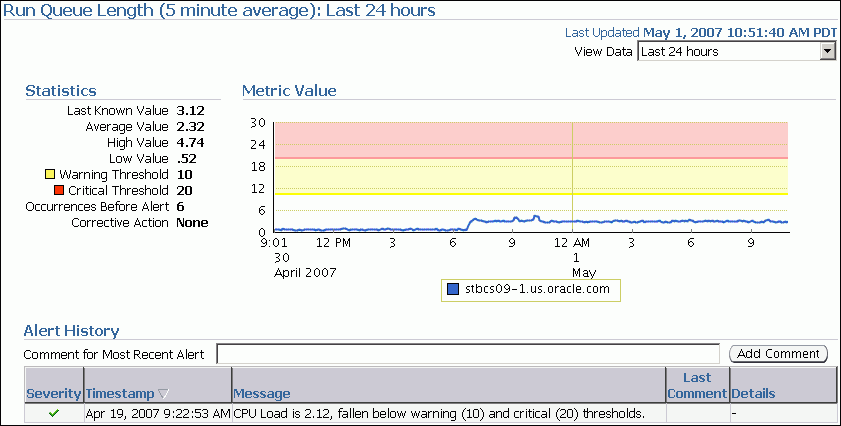
In this example, the CPU load crossed the warning threshold, but it is still below the critical threshold, so an alert was not generated.
If you notice an unexpected spike in this value that is sustained through normal workload hours, then a CPU performance problem might exist.
Return to the CPU Details view of the Host Performance subpage and review the Top 10 Processes table.
If a process is consuming too much of the CPU utilization percentage, then this process should be investigated.

In this example, the database is consuming 100 percent of CPU utilization. Therefore, the database is the likely source of a potential CPU performance problem and should be investigated.
If a CPU performance problem is identified, then you can try to resolve the issue by doing the following:
See Also:
Oracle Database Performance Tuning Guide for information about resolving CPU issues
Oracle Database Administrator's Guide for information about Oracle Database Resource Manager
Operating system performance issues commonly involve process management, memory management, and scheduling. This section describes how to monitor memory utilization and identify problems such as paging and swapping.
To monitor memory utilization:
From the Database Home page, click Performance.
The Performance page appears.
In the Host chart, click Load Average in the legend.
The Host page appears, showing the Performance subpage.
Select Memory Details from the View list.
The Memory Details view of the Performance subpage appears.
This view contains statistics about memory utilization, page scan rates, and swap utilization gathered over the last hour. The top 10 processes are also listed ordered by memory utilization.

Verify the current memory page scan rate using the Memory Page Scan Rate chart.
The current value of the memory page scan rate is displayed below the chart. On UNIX-based systems, this value represents the number of pages scanned per second. On Microsoft Windows, this value represents the rate at which pages are read from or written to disk to resolve hard page faults. This value is a primary indicator of the kinds of faults that may be causing systemwide delays.
Click Memory Scan Rate.
The Memory Page Scan Rate page appears.
This page contains memory page scan rate statistics and related alerts over the last 24 hours.
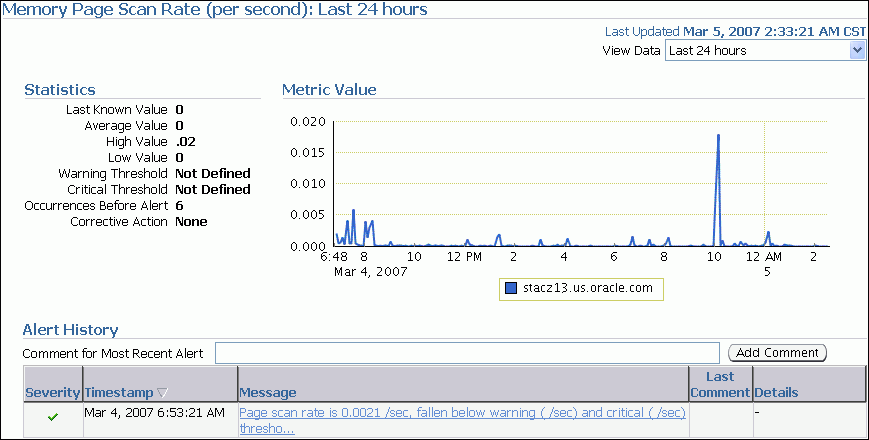
In this example, an alert is not generated because a threshold is not defined.
If you notice an unexpected spike in this value that is sustained through standard workload hours, then a memory performance problem might exist.
Verify the current memory utilization using the Memory Utilization chart.
The Memory Utilization chart shows how much memory is being used. The current value of memory utilization is displayed below the chart. During standard workload hours, the value should not exceed the warning threshold (shown in yellow).
Click Memory Utilization.
The Memory Utilization page appears.
This page contains memory utilization statistics and related alerts generated over the last 24 hours.
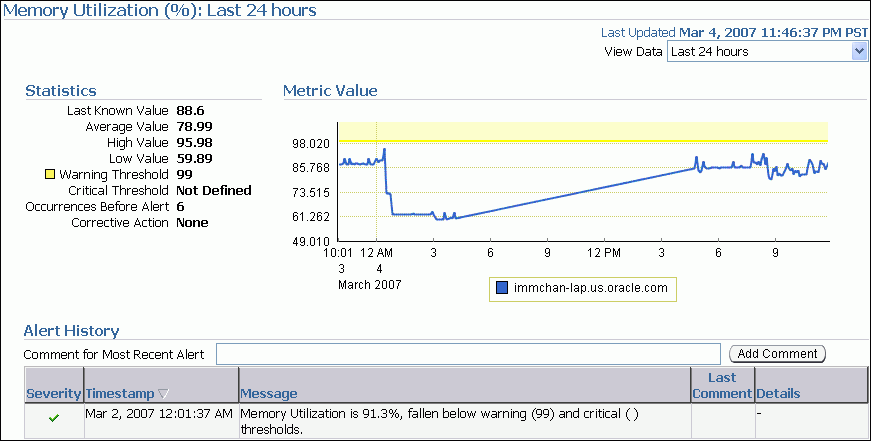
In this example, memory utilization is near, but does not exceed, the warning threshold value (99 percent), so an alert is not generated.
If you notice an unexpected spike in this value that is sustained through normal workload hours, then a memory performance problem might exist.
Verify current swap utilization using the Swap Utilization chart.
The Swap Utilization chart shows how much swap space is being used. The current value of swap utilization is displayed below the chart. During normal workload hours, the value should not exceed the warning threshold.
Click Swap Utilization.
The Swap Utilization page appears.
This page contains swap utilization statistics and related alerts generated over the last 24 hours.
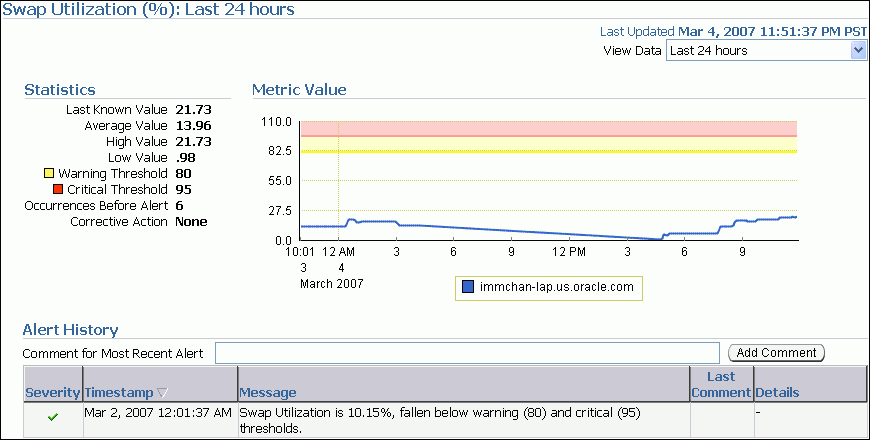
In this example, swap utilization is below the warning threshold, so an alert is not generated.
If you notice an unexpected spike in this value that is sustained through normal workload hours, then a memory performance problem might exist.
On the Memory Details view of the Host Performance subpage, verify the top processes in the Top 10 Processes table.
If a process is taking up too much memory, then this process should be investigated.
In this example, the database is consuming 82.86 percent of the CPU. The resident size is 259 MB, while the virtual size is 391 MB. Therefore, the database is the likely source of a potential memory problem and should be investigated.
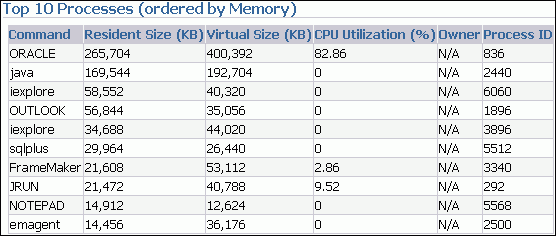
If a memory performance problem is identified, you can attempt to resolve the issue by doing the following:
Using Automatic Memory Management to automatically manage and distribute memory between the System Global Area (SGA) and the aggregate program global area (PGA aggregate)
Using the Memory Advisor to set SGA and PGA memory target values
Using Automatic PGA Management to manage SQL memory execution
Avoiding running too many processes that use a lot of memory
Reducing paging or swapping
Reducing the number of open cursors and hard parsing with cursor sharing
See Also:
Oracle Database Administrator's Guide for information about using Automatic Memory Management
Oracle Database 2 Day DBA for information about using the Memory Advisor
Oracle Database Performance Tuning Guide for information about resolving memory issues
Because the database resides on a set of disks, the performance of the I/O subsystem is very important to the performance of the database. Important disk statistics include the disk I/Os per second and the length of the service times. These statistics show if the disk is performing optimally or if the disk is being overworked. This section describes how to monitor disk I/O utilization.
To monitor disk I/O utilization:
From the Database Home page, click Performance.
The Performance page appears.
In the Host chart, click Load Average in the legend.
The Host page appears, showing the Performance subpage.
Select Disk Details from the View list.
The Disk Details view appears.
This view contains disk I/O utilization and service time statistics gathered over the last hour, and the top disk devices ordered by busy percentage.
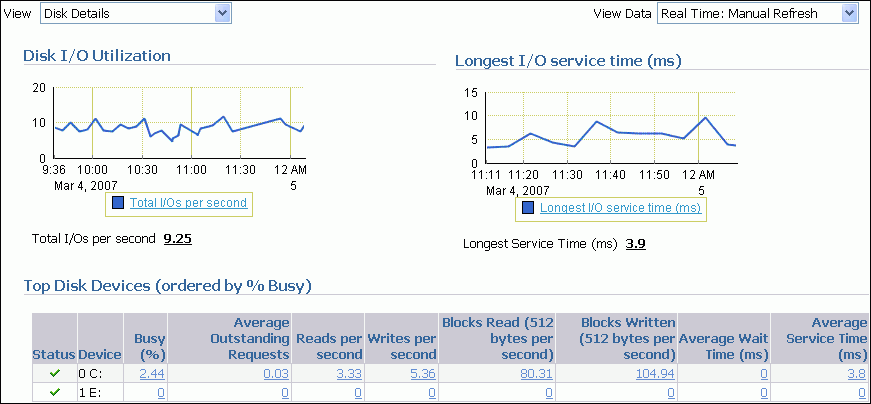
Verify the current disk I/O utilization using the Disk I/O Utilization chart.
The Disk I/O Utilization chart shows how many disk I/Os are being performed per second. The current value for total I/Os per second is displayed below the chart.
Click Total I/Os per Second.
The Total Disk I/O Per Second page appears.
This page contains disk utilization statistics and related alerts generated over the last 24 hours.

In this example, an alert is not generated because a threshold is not defined.
If you notice an unexpected spike in this value that is sustained through standard workload hours, then a disk I/O performance problem might exist and should be investigated.
Verify the current I/O service time using the Longest I/O Service Time chart.
The Longest I/O Service Time chart shows the longest service time for disk I/Os in milliseconds. The current value for longest I/O service time is displayed below the chart.
Click Longest I/O Service Time.
The Longest Service Time page appears.
This page contains I/O service time statistics and related alerts generated over the last 24 hours.
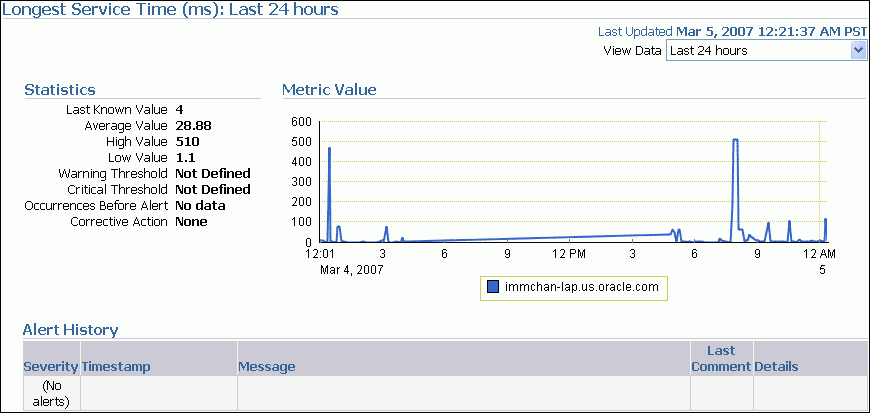
In this example, an alert is not generated because a threshold is not defined.
If you notice an unexpected spike in this value that is sustained through normal workload hours, then a disk I/O performance problem might exist and should be investigated.
On the Disk Details page, verify the disk devices in the Top Disk Devices table.
If a particular disk is busy a high percentage of the time, then this disk should be investigated.
In this example, the drive that hosts Oracle Database (drive C) is only busy about 2.82 percent of the time, and there does not appear to be a disk performance problem.

If a disk I/O performance problem is identified, you can attempt to resolve the problem by doing the following:
Using Automatic Storage Management (ASM) to manage database storage
Striping everything across every disk to distribute I/O
Moving files such as archived redo logs and online redo logs to separate disks
Storing required data in memory to reduce the number of physical I/Os
See Also:
Oracle Database Performance Tuning Guide for information about resolving disk I/O issues
You can customize the Performance page so that it specifically addresses your requirements. As explained in "Monitoring Instance Activity", you can specify which charts you want to appear by default in the Performance page, and how you want them to appear. You can also decide whether to include baseline values in the Throughput and Services charts.
Enterprise Manager stores persistent customization information for each user in the repository. Enterprise Manager retrieves the customization data when you access the Performance page and caches it for the remainder of the browser session until you change the settings.
To customize the Performance page:
From the Database Home page, click Performance.
The Performance page appears.
On the Performance page, click Settings.
The Performance Page Settings page appears.
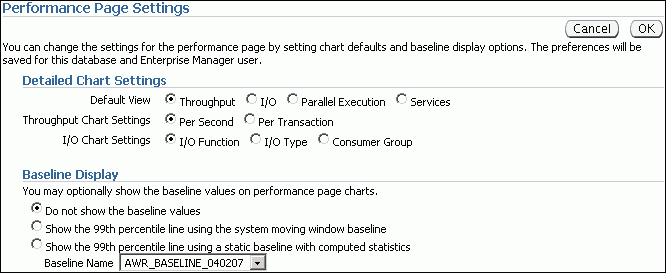
In the Detailed Chart Settings section, choose the defaults for display of the instance activity charts. Complete the following steps:
In Default View, select the instance activity chart to appear by default in the Average Active Session section.
See "Monitoring Instance Activity" for a description of the Throughput, I/O, Parallel Execution, and Services charts.
In Throughput Chart Settings, select Per Second or Per Transaction as the default instance throughput rate to be displayed in the Throughput chart.
See "Monitoring Throughput" to learn how to use the Throughput charts.
In I/O Chart Settings, select the default I/O breakdown to be displayed in the I/O chart.
See "Monitoring I/O" to learn how to use the I/O charts.
In the Baseline Display section, choose how Automatic Workload Repository (AWR) baselines will be displayed in the performance charts. Do one of the following:
Select Do not show the baseline values to prevent baselines from appearing.
Select Show the 99th percentile line using the system moving window baseline to specify a percentile to display for the Throughput and Services charts.
Note that the 99th percentile is a very high significance level.
Select Show the 99th percentile line using a static baseline with computed statistics and then select a baseline name from the Baseline Name list.
Note that you can select only baselines that have undergone schedule statistics computation, as described in "Computing Threshold Statistics for Baselines".
Click OK.
The Performance page reappears.
The charts are now displayed according to your customization settings.